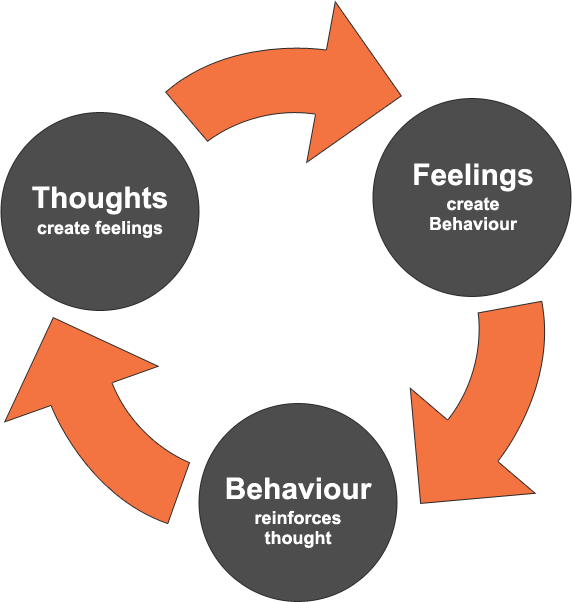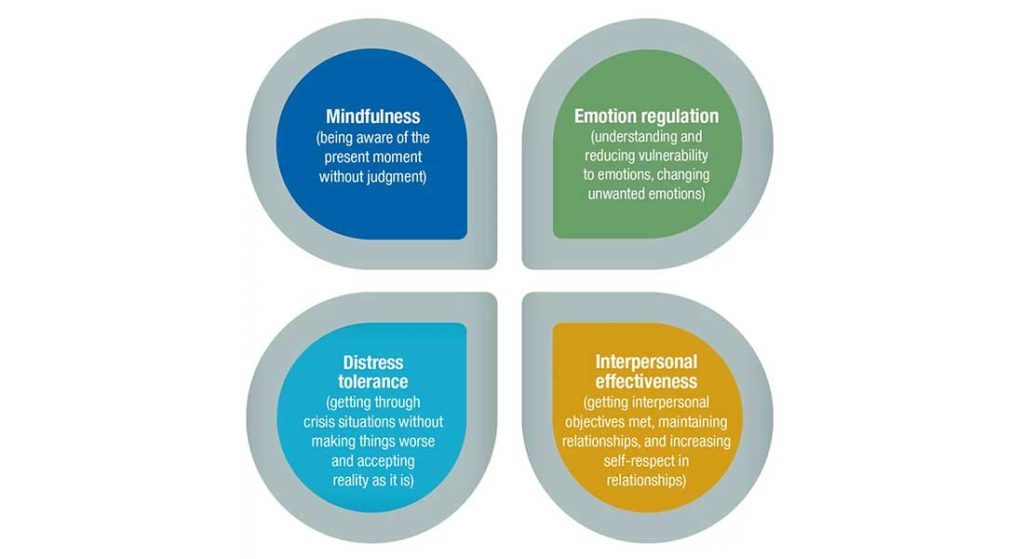Psychotherapy is one of the best treatment methods available for a number of mental illnesses. One of the most common types of therapy is called Cognitive Behavioral Therapy (CBT). Also called talk therapy, CBT focuses on talking about your problems to help you frame your thoughts differently. If you feel like negative thoughts are always in control – “I am a failure. I can’t do anything right. No one will like me if they see who I really am.” – CBT can help you use logic and reason to flip the script and be in control of your thoughts instead of allowing your thoughts to control you.

CBT is based on the idea that our thoughts and behaviors influence our feelings, so changing the way we think about and react to situations will help us feel better.
However, standard CBT isn’t effective in treating all mental illnesses. Another common type of therapy is called Dialectical Behavior Therapy (DBT). DBT is a more specific form of CBT that focuses on helping people who tend to have extreme emotional reactions interact with the environment around them in a less emotional, healthier way
With such similar names, are CBT and DBT that different from each other, and can using one have benefits over using the other? Read on to learn about the differences between CBT vs DBT and how to figure out which one will best help you.
CBT is a General Term
CBT is a catch-all phrase for therapies that share common characteristics. DBT is a type of CBT, along with several other types. Therapists who practice CBT generally practice talk therapy that relies on several guiding features. Those features include:
Treats Emotional Response: based on the idea that our thoughts influence our feelings, so changing the way we think about and react to situations will help us feel better.
Limited to a Specific Period of Time: most patients will seek treatment for a a period of time and then start to apply CBT strategies on their own without significant support from a mental health professional. If mood or behavior problems persist, clients may then progress to a different type of therapy to address a specific trauma or other issue that continues to cause pain or be a barrier to healthy living.
Having a Good Therapist-Patient Relationship: CBT works best when the patient feels like they can trust their therapist. Because of the personal nature of therapy, patients should seek out someone they respect and feel comfortable with.
Relies on Cognition and Rationale: CBT encourages patients to apply logic and reason to help direct how they respond to situations instead of letting emotions do all the driving.
Uses Structure to Guide Treatment: therapists have a specific reason for the techniques and methods they bring up in each session. They use the client’s goals to figure out which CBT concepts will be most beneficial to them and tailor each one accordingly.
While DBT is a type of CBT, it is tailored towards helping people acknowledge the pain and discomfort they feel, yet still feel safe and “ok” in the moment and empowered to choose healthy behaviors instead of impulsive or harmful actions. While some emphasis is put on dealing with thoughts, patients are taught to identify triggers outside of themselves and match those triggers with a healthy coping mechanism or response.
CBT Program at Skyland Trail
CBT vs DBT for Treating Certain Illnesses
Not all mental illnesses respond to treatment in the same way. A therapy technique that works well for depression and anxiety can exacerbate eating disorders or personality disorders.
CBT has been shown to be incredibly effective when treating depression, and is more likely to make depression go into remission than other types of therapy. This method of therapy has also been proven beneficial in treating anxiety, as it gives patients control over their recovery. CBT has also been shown to help with obsessive compulsive disorder (OCD), phobias, panic disorder, post-traumatic stress disorder, and sleeping issues.
DBT was created to help those diagnosed with borderline personality disorder. DBT focuses on helping people change their behavior patterns, as opposed to trying to think or talk through the issues they are struggling with. This type of CBT helps those who have developed patterns of intense emotional reactions and impulsive behaviors in response to what patients describe as overwhelming feelings of pain and rejection – the feeling of walking through a world filled with knives. DBT often is the most effective therapy for those who struggle with self-harm behaviors like cutting and chronic suicidal ideation. Sexual trauma survivors also respond well to DBT techniques.

DBT often is the most effective therapy for people with borderline personality disorder and those who struggle with self-harm or chronic thoughts of suicide.
Philosophies Used in CBT vs DBT
CBT focuses on reasoning and rationale, as most commonly found in stoic philosophy and the Socratic Method. The Socratic Method uses critical thinking to question assumptions in place. This works well for those who suffer with anxiety and depression, as it helps them to see their problems from a more logical point of view. For example, clients who struggle with feelings of failure and inadequacy are asked to look at the facts. When have they in fact been successful at accomplishing a goal? Are there other people – friends, family or co-workers – who could give evidence of the client’s success in different situations? Who or what are they using as a measuring stick for success? Is that a realistic comparison?
DBT relies heavily on mindfulness skills used in Buddhism and Zen practices. DBT teaches patients to use specific mindfulness techniques to learn to live with pain in the world and accept how things are instead of suffering by trying to change them.
The Difference in Treatment Methods
CBT focuses on how your thoughts, feelings and behavior influence each other. While DBT does work on these things, emphasis is given more towards regulating emotions, being mindful, and learning to accept pain. CBT seeks to give patients the ability to recognize when their thoughts might become troublesome, and gives them techniques to redirect those thoughts. DBT helps patients find ways to accept themselves, feel safe, and manage their emotions to help regulate potentially destructive or harmful behaviors.
Clients who engage in DBT therapy participate in DBT skills training sessions that are typically taught in a group setting in four modules. Most patients also meet weekly with a DBT therapist or DBT coach and receive DBT phone coaching as needed when they need help the most. Sometimes, once patients are able to use DBT skills to regulate their emotions, practice mindfulness, and improve relationships with others, they are able to transition to more standard CBT groups to address specific negative thought patterns or recurring harmful behaviors.
DBT Programs at Skyland Trail
How to Tell if CBT or DBT is Right For You
The best way to figure out which type of therapy treatment is best for you is to talk with a mental health professional – a therapist, psychiatrist or psychologist. They will consider your symptoms, treatment history, and the goals you outline for what you want out of therapy, and recommend the best next steps.
What Is Your Diagnosis?
Because each illness responds differently to treatment techniques, you will want to go with the method that has been shown most effective for treating your diagnosis and symptoms. If you have not yet received a diagnosis from a psychiatrist or psychologist, consider setting an appointment for psychiatric diagnosis and psychological testing. This will help you identify the best treatment options, as well as strengths and existing skills you can leverage in your recovery process.
Depression and anxiety sufferers have found a lot of success with CBT, while people with borderline personality disorder and chronic thoughts of suicide find DBT more helpful. Keep in mind that many people have more than one diagnosis, and sometime people use elements from both DBT and CBT to manage their symptoms.
Have You Tried Therapy Already?
Many individuals who have gone to therapy say they don’t want to go back because they feel like it wasn’t effective. Because the patient-therapist relationship is so important, consider interviewing a few other therapists to see if you can find a better match. You may also want to consider trying a different “flavor” of CBT. In addition to DBT, there is a whole alphabet soup of other variants of CBT including Acceptance and Commitment Therapy (ACT) and Mindfulness Based Cognitive Therapy (MBCT). If a goal of therapy is to improve your relationships with others, consider trying couples therapy or family therapy instead of going it alone.
And give it a few weeks before you call it quits. Remember that your therapist is not going to do the work for you. You will need to commit to doing the hard work of making changes in your life to support healthier thinking, healthier behaviors, and healthier living. Recovery doesn’t happen overnight, but by using a therapeutic treatment matched to your symptoms, and finding the right therapist or psychiatric treatment program, you can gradually make a series of small changes that add up to less pain and a better life.
With so many treatment options out there, it can be confusing to know what techniques will best help you. CBT and DBT are some of the more common therapy practices, and have been shown to help individuals suffering from a number of mental illnesses. Skyland Trail offers both CBT and DBT in our residential treatment and day treatment programs. Contact our admissions team to learn more about how our mental health treatment programs may help you or a loved one.
Sharing is caring...

No comments:
Post a Comment